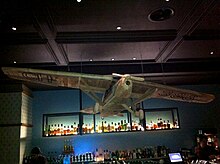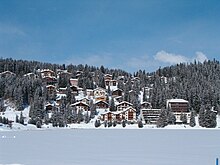Arosa airfield
The airfield Arosa was a winter landing strip for light passenger aircraft in the Swiss spa and resort Arosa . It existed between 1932 and 1936 and was located in the middle of the Arosa village area on the frozen Obersee .
History of origin
The Arosas spa administration, headed by Hans Roelli , examined the possibility of creating a permanent airfield for the first time in 1921. She therefore contacted the aviation pioneer Alfred Comte , who unsuccessfully looked around for a suitable location in the Isel not far from the reservoir . In the following years further efforts were made in this regard, but no location was found for a place that could be operated all year round.
On March 2, 1932, the Zurich sports pilot Robert Fretz landed for the first time with his De Havilland DH.80 Puss Moth , license plate CH 260, on the Obersee, on which a runway had been prepared in the snow. Annoying telephone cables in the approach lane and two lighting supports on the nearby Upper Ice Rink had previously been removed. Fretz had prepared intensively for the company and had specially simulated the demanding landing conditions in Arosa with structural measures on Lake Davos . This first flight took him from Davos in a direct line to Arosa, which he reached via Sunnenrüti and Maran from the north-east. Fretz had to fly a few loops over the village in order to be able to land safely on the lake from the south. Because of this success, it was decided to take up the Arosa airfield project again.
On January 7, 1933, Fretz landed again on the Obersee with the same plane. As a result, he started various flight attempts from there and took selected guests on short sightseeing flights, including the Belgian regent couple, King Albert I and his wife Elisabeth Gabriele in Bavaria, who were present on vacation . In order to check whether the runway would also be suitable for glider pilots , the Kurverein financed a test with the Swiss glider pilot Farner with 1,500 Swiss francs , which Fretz - accompanied by a double-decker - towed from Dübendorf airfield over the target area.

After this undertaking was also successful, Fretz was granted a further CHF 2,000 to build a collapsible aircraft hangar next to the old forge on the lake shore. The Kurverein Arosa also decided in autumn 1933 to purchase its own aircraft for CHF 20,000, in which the community contributed with CHF 5,000. Arosa was the first Swiss health resort to have its own passenger plane. The brand new three- seater De Havilland DH.85 Leopard Moth , CH 388, was leased for four years to Robert Fretz, who wanted to carry out the flights on his own account. On February 2, 1934, the machine was transferred to Schanfigg and officially named "Arosa" on the same day. From now on, Fretz organized regular post, sightseeing and scheduled flights to Davos, St. Moritz , Lenzerheide , St. Gallen and Zurich during the winter season .
In the coming winters, Fretz completed around 400 flight hours each time. In the summer, the “Arosa” was stationed in Altenrhein with an analogue order and the hangar on the Obersee was used to hold the equipment required for the Arosa horse races during the summer .
Airfield
The runway, which is just over 300 meters long, ran parallel to the tracks at Arosa station in a north-south direction. The municipality was responsible for the preparation of the runway, and the Kurverein was responsible for the hangar and operational organization. The take-offs took place southwards from today's Haus Mariposa over the Ochsenbühl in the direction of Untersee , the landings in the opposite way. The stands of the EHC Arosa and the lighting masts on the upper ice rink definitely had to be relocated. Shortly before take-offs and landings, a short section of Poststrasse between today's sports and congress center and the current post office building was closed to all traffic. This happened through optical and acoustic signals, which the chestnut seller stationed at Haus Jelen triggered in his booth by pressing a button. During the annual horse races on the Obersee, flight operations were suspended.
End of permanent flight operations
In 1937 Fretz accepted a call from Swissair and was employed by them as a line pilot. Since no suitable successor could be found who could continue flight operations on the previous basis, the Kurverein sold the aircraft to the Swiss Aero Club for CHF 12,000 . At first it was thought of continuing the Arosa passenger flight service with a rented sports aircraft . However, since the airstrip was in the middle of the settlement area, there was considerable resistance from the population due to the large noise emissions . The planned year-round operation, for which an acceptable location near the village was still not found, remained unsolved. The outbreak of the Second World War with the corresponding collapse of general tourism business finally brought this project to an end. Nevertheless, the slope remained marked in the Arosa local maps for some time.
Todays situation
Today Arosa has a helicopter landing pad at the sewage treatment plant in the Isel and another one for medical emergencies at the snow dump below the Tannenhof on Schanfiggerstrasse . The latter replaced the landing site at the former Surlej clinic on the Obersee.
On March 7th and 8th, 2015, a flight day with fly-ins from a total of 14 glacier planes took place in the Isel in the area of the flat gravel bed of the Welschtobelbach, which is still snow-covered, south-northward . The pilots took off from various airfields - including Mollis , Wangen , Fehraltorf , Bex , Geneva , Beromünster , Bad Ragaz and Stuttgart - and flew to the landing site from the Langwieser Viaduct . The sporting event was organized by the Aero-Club Ostschweiz with the participation of Arosa Peter Meisser and Rudolf Homberger. In a new fly-in in March 2018, the pilot and the passenger of a small aircraft died, which did not gain height during take-off and collided with the steel cable bridge that crossed the bed of the Welschtobelbach at the northern end of the temporary runway.
Varia
The local ski racer David Zogg was flown home with the “Arosa” from St. Moritz to the official reception after his world championship title in 1934.
literature
- Marcel Just, Christof Kübler, Matthias Noell (eds.): Arosa - Modernism in the mountains . gta, Zurich 2007, ISBN 978-3-85676-214-8 , pp. 48–51.
- Hans Danuser : Arosa - as it was then (1928–1946) , vol. 3, self-published by Danuser, Arosa 1999, pp. 80, 90 ff., 107, 110, 121, 145, 156, 180.
- Fritz Maron: From mountain farming village to world health resort Arosa , Verlag F. Schuler, Chur 1934, p. 136.
Web links
- Information on the CH 388 «Arosa» aircraft at www.lsze.ch (PDF file; 10 kB)
Individual evidence
- ↑ Video clip with flight images over Arosa from Robert Fretz's plane
- ↑ Video clip 1 about the landings by Robert Fretz (CH 260), glider pilot and biplane (CH 330)
- ↑ Video clip 2 about the landings by Robert Fretz (CH 260), glider pilots and biplanes (CH 330)
- ↑ Video clip with impressions from Robert Fretz and the CH 388
- ↑ Video clip with the take-off and landing of the CH 388
- ↑ Aroser Zeitung of March 20, 2015, p. 7.
- ↑ Aroser Zeitung of March 13, 2015, p. 10 f.
- ↑ Information on the Arosa Fly-in 2015 at www.aeco.aero with additional links ( memento of the original from May 18, 2015 in the Internet Archive ) Info: The archive link was automatically inserted and not yet checked. Please check the original and archive link according to the instructions and then remove this notice.
- ↑ Video impression from the Arosa Fly-in 2015 on youtube.com
- ↑ Two deaths in a small plane crash in Arosa. In: Tagesanzeiger. March 24, 2018, accessed March 26, 2018 .
Coordinates: 46 ° 47 ′ 4 " N , 9 ° 40 ′ 53" E ; CH1903: 771,244 / 183930



